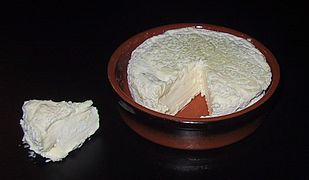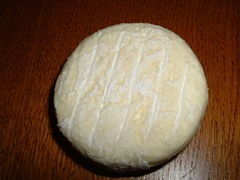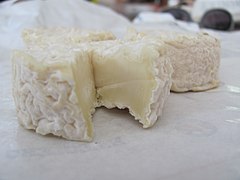User:Amissta14/sandbox
Terroirs and culinary influences
[edit]As a result of Lyon’s geographical location, many different culinary influences have converged in the city’s cuisine,[1] particularly those of the South (Province and the Mediterranean) and of the North (Alsace and Lorraine). Each cuisine imparts its own characteristics: the use of butter and cream from the North and of fresh vegetables and olive oil from the South. In addition, in the fifteenth century, Lyon served as one of the primary distribution centres for spices imported from the East by Italian merchants.[2]
There are a number of terroirs around Lyon whose farmers supply their products to the city. To the north of Lyon lies Charolais, whose cattle breeders provide beef, while the fishermen of the Saône River deliver whitebait. The wine-producing region of Beaujolais is also located to the north of Lyon. According to French writer and journalist Léon Daudet,“[there] are three reasons why Lyon is the capital of French gastronomy. . . . The third is that in addition to the Saône and the Rhône, she is served by a third river, the Beaujolais, which never dries up and is never muddy.”[3]
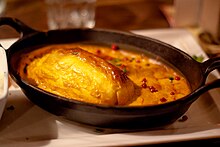
Located north-east of Lyon, the region of Bresse supplies poultry, the appellation d’origine contrôlée (En: controlled designation of origin) of which dates to 1957.[4] Bresse also supplies gaudes, corn used to make soupe de farine jaune (En: corn flour soup).[5] The neighbouring region of Bugey provides wine as well as crayfish, which are caught in the lac de Nantua (En: Nantua Lake) and are used as the base of the Nantua sauce that often accompanies quenelles. Frogs, along with several types of fish including carp, tench, roach, pike and zander, are also supplied by the Dombes,[6][7] a glacier-gouged plateau[8] made up of more than 1,000 ponds[9] (sometimes referred to as lakes), the majority of which are man-made and were created during the Middle Ages.[10]
The regions to the south of Lyon produce fruits, vegetables and wines in the Vallée du Rhône (En: Rhône Valley).[11] In the Ardèche, a department in south-central France named after the Ardèche River, farmers continue to develop the cultivation of chestnuts, which are a key ingredient in the traditional French Christmas dish, turkey with chestnuts. The Dauphiné region, which is known for its pork products and cheeses such as the Saint-Felicien[12] or the Saint-Marcellin,[13] is also located to the south of Lyon as are the 48 communes[14] that produce rigotte de Condrieu,[15] “. . . a soft French goat cheese with a bloomy rind . . . [that] takes its name from the word ‘rigot’ (meaning small stream) and the town of Condrieu, 40 kilometers south of Lyon.”[16]
-
Saint-Felicien
-
Saint-Marcellin
-
Rigottes de Condrieu
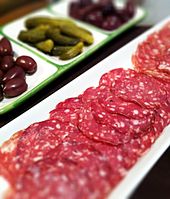
To the west of Lyon, the livestock farms of the Monts du Lyonnais (Lyonnais mountains) are the source of the charcuterie and salt meat known as cochonnailles lyonnaises as well as variety of other pork products including rosette de Lyon, a cured sausage named for its pink colour and made from pork shoulder,[17] and jésus de Lyon, which is a “large, coarsely chopped, pure pork sausage studded with large pieces of fat [whose] plump shape resembles a swaddled baby.”[18] These farmers also produce sausage, salami, pigs' trotters, ham, filet mignon, terrines, farmhouse pâté and pork rind (including fried pork rinds) as well as small artisanal cheeses or rigottes that are generally made of cow or goat milk. In addition, agricultural producers from this region, primarily market gardeners, are often present at the markets of Lyon. For instance, the French commune of Thurins calls itself the raspberry capital of France.[19]
Traditions
[edit]The Mères
[edit]The name Mères lyonnaises (En: Mothers of Lyon) refers to the female cooks who gave birth to Lyon’s current gourmet reputation.[20] Their history was linked to the rise of automobile tourism, as promoted by the Michelin Guide,[21] and the development of the city of Lyon under mayor Edouard Herriot.[22] In the mid-18th century, these women of modest means, initially the cooks in large middle-class households in Lyon, decided to start their own businesses, serving dishes that mixed homemade and traditional cuisine.[23] Many more women joined their numbers during the Great Depression, when they were let go from the wealthy households that employed them.[24]
While starting out serving a client base of working class people, such as journeymen,[25] in this industrial city, the reputation of their meals soon spread to a much wealthier clientele. Celebrities, businessmen and politicians came to frequent these establishments despite the mixing of the social classes, particularly in the Golden Age of the Mères, during the Inter-War period. They offered a menu that was simple (four or five traditional dishes[26]) yet refined enough to guarantee both culinary pleasure and a welcoming ambiance.[27]
The first historical mention of a Mère dates back to Mère Guy in 1759.[28] Located on the Rhône River in the Mulatière region, her self-named guinguette (En: open-air restaurant) specialized in matelote d'anguilles, a dish of stewed eels in white/red-wine sauce.[29]
A century later, her granddaughters, referred to as La Génie (En: the Genius) and Maréchal,[30] became the new face of Mère Guy, bringing back classic recipes, including their grandmother's stewed eels, the dish that "made the Mère Guy reputation."[31][32] This reputation attracted honoured guests, including the Empress Eugénie on her annual visit to the thermal waters of neighbouring Aix-les-Bains.[33]
Around this time (1830-1850), Mère Brigousse ran a restaurant in the Charpennes district of Lyon. One of her most popular dishes was Tétons de Vénus (En: Venus' breasts), large breast-shaped quenelles.[34]
Mère Fillioux (Françoise Fillioux, 1865-1925) was the first Mère whose “reputation was known well beyond the limits of the city and region.”[35][36] She established a restaurant on 73 rue Duquesne, known for a simple, unchanging menu featuring her own culinary creations, such as volaille demi-deuil (En: fowl in half-mourning). The dish takes its name from her technique of cooking "a fattened hen with slivers of truffle inserted between skin and flesh. The alternating black and white appearance of the flesh explains the term ‘half mourning’, a period following the all-black dress of full mourning, when it was acceptable for widows to alternate black and white or grey clothing."[37][38]
Specialities such as these, “turned out with such generosity and devotion to perfection...made her famous to gourmets the world over within her lifetime.”[39]
As early as the 1920's, Mère Bourgeois (Marie Bourgeois) was making a name for herself in the region. In 1933, she became one of the first women to receive 3 stars from the Michelin Guide for her restaurant in Priay, in the Rhône-Alpes department of Ain.[40]

That same year, Mère Brazier (Eugénie Brazier, 1895-1977), “the highest achiever”[41] of all the Mères, was awarded this distinction for both of her restaurants, one on 12 rue Royale and the other on Col de la Luère in Lyon, giving her a total of 6 stars.[42] Trained by the renowned[43] Mère Fillioux,[44] she was "the first woman to receive [this many stars] for two restaurants simultaneously"[45][46] and “rose to become Lyon’s most renowned chef”[47] of the time. Guests of Mère Brazier included the mayor, Edouard Herriot,[48] and celebrities such as poet/screenwriter Jacques Prévert and singer Édith Piaf.[49]

Paul Bocuse, a chef “more famous [in Lyon] than whoever happens to be mayor”[50] and the longest-standing recipient of 3 Michelin stars (over 40 years), apprenticed under Mère Brazier.[51] Bocuse attributes much of his success to those formative years, a sentiment echoed “by many of Lyon’s great chefs”[52][53] who received similar culinary training under les Mères.[54]
Among these chefs is Alain Alexanian (L'Alexandrin restaurant and A Point Café), whose career began with an apprenticeship under Mère Castaing (Paulette Castaing), a two-time Michelin star recipient for her restaurant L'Ouest in Beau-Rivage, in the Condrieu region.[55]
Chef Georges Blanc was similarly influenced by his grandmother Élisa, known as Mère Blanc,[56] whose restaurant in Vonnas became the seat "of a veritable [family] dynasty of great chefs."[57][58] In 1933, she was described as “the best cook in the world”[59][60] by Curnonsky, a well-known[61] food critic.
Other Mères include Mère Vittet, who established a restaurant near Lyon's Perrache train station,[62] and Mère Léa, who ran La Voûte (En: the Vault) in Lyon's Place Antonin Gouju.[63] Some of her dishes included tablier de sapeur (literally meaning sapper's apron - a dish of pan-fried tripe), macaroni gratin, and choucroute au champagne (an adaptation of choucroute garnie, “sauerkraut cooked and served with meat,”[64] usually “pork, sausages and often potatoes”[65] made with Champagne instead of Riesling[66]), for which she was awarded a Michelin star.[67] Known as a woman who was quick to share her opinions (often quite loudly), Mère Léa would go to the Saint Antoine market each morning pushing a large cart with a sign that read “Attention! Faible femme, forte en gueule” (En: Beware! Weak woman, strong voice).[68]
Still others include Mère Pompom, Mère Charles, La Grande Marcelle, Mère Jean,[69] La Mélie,[70] Mère Carron, Madame Andrée and Tante Paulette.[71]
- ^ http://www.bonjourparis.com/story/lyon-a-city-for-all-seasons/
- ^ Lach, Donald F. Asia in the Making of Europe, Volume I: The Century of Discovery, Book 1. (Chicago: University of Chicago Press, 1994) 124. ISBN: 0226467317
- ^ Chelminski, Rudolph. “Chapter IV.” I’ll Drink to That: Beaujolais Wine and the French Peasant Who Made it the World’s Most Popular Wine. (New York: Penguin Books (USA) Inc., 2007). ISBN: 1440619743
- ^ http://www.bresse-bourguignonne.com/enjoy-the-food/bresse-poultry-2-33.htm
- ^ Kamm, Madeleine. When French Women Cook - A Gastronomic Memoir with Over 250 Recipes. (New York: Random House LLC, 2010). 142. ISBN: 9781580083652
- ^ http://ladombes.free.fr/La_peche_dans_l_Ain/Etangs_de_peche_a_la_ligne.htm
- ^ Lichtfouse, Eric, ed. Agroecology and Strategies for Climate Change. (New York: Springer, 2012) 21-22. ISBN: 9400719040
- ^ Bailey, Rosemary, et al. DK Eyewitness Travel Guide: France. (New York: DK Publishing, 2012) 376. ISBN: 0756684048
- ^ Williams, D. Dudley. The Biology of Temporary Waters. (New York: Oxford University Press Inc., 2006) 216. ISBN: 0191523690
- ^ Williams, D. Dudley. The Biology of Temporary Waters. (New York: Oxford University Press Inc., 2006) 215. ISBN: 0191523690
- ^ http://www.rhone-wines.com/en/identite-histoire
- ^ http://www.cheese.com/saint-felicien/
- ^ http://www.cheese.com/saint-marcellin/
- ^ http://www.rigottedecondrieu.fr/
- ^ http://eur-lex.europa.eu/LexUriServ/LexUriServ.do?uri=OJ:C:2013:130:0015:0019:EN:PDF
- ^ http://www.culturecheesemag.com/cheese-library/Rigotte-de-Condrieu-
- ^ Bhagianathan, Chris, ed. et al. Sausage, A Country-by-Country Photographic Guide with Recipes. (New York: DK Publishing, 2012) 50. ISBN: 1465400923
- ^ Bhagianathan, Chris, ed. et al. Sausage, A Country-by-Country Photographic Guide with Recipes. (New York: DK Publishing, 2012) 50. ISBN: 1465400923
- ^ http://www.thurins-commune.fr/
- ^ Willan, Anne, and Amy Friedman. “Chapter Five.” One Soufflé at a Time: A Memoir of Food and France. (New York: St. Martin’s Press, 2013). ISBN: 0312642172
- ^ http://www.michelintravel.com/about/
- ^ http://www.britannica.com/EBchecked/topic/263774/Edouard-Herriot
- ^ http://www.canalacademie.com/ida4127-Les-meres-lyonnaises-un-modele-de-gastronomie.html?var_recherche=lyonn
- ^ http://exploratricedesaveurs.com/2012/01/22/mais-qui-sont-ces-fameuses-meres-lyonnaises/
- ^ Verney-Carron, Luc. Cuisine lyonnaise. (Edisud, 2007) 5. ISBN: 2744906492
- ^ http://www.franceculture.fr/emission-la-fabrique-de-l-histoire-histoire-de-la-gastronomie-24-2010-11-23.html
- ^ http://exploratricedesaveurs.com/2012/01/22/mais-qui-sont-ces-fameuses-meres-lyonnaises/
- ^ http://exploratricedesaveurs.com/2012/01/22/mais-qui-sont-ces-fameuses-meres-lyonnaises/
- ^ Combes, Steve. Dictionary of Cuisine French. (London: Barrie Books Ltd., 1962) 46. ISBN: 0091442419
- ^ http://www.patrimoine-lyon.org/index.php?lyon=la-gastronomie-lyonnaise
- ^ Original French text: qui a fait la reputation du lieu
- ^ http://www.patrimoine-lyon.org/index.php?lyon=la-gastronomie-lyonnaise
- ^ http://www.toutpourlesfemmes.com/conseil/Meres-Lyonnaises-Modele-de.html
- ^ http://exploratricedesaveurs.com/2012/01/22/mais-qui-sont-ces-fameuses-meres-lyonnaises/
- ^ (Original French text: la première mère lyonnaise dont la réputation dépassa largement les limites de la ville et de la region)
- ^ Serex, Anthony. Le dico de Lyon. (Petit Futé, 2012). ISBN: 2746965232
- ^ Original French text: poularde au jus où l’on introduit entre chair et peau des lamelles de truffe. L’alternance des zones noires des tranches de truffe et des interstices blancs de la chair de la poularde explique la dénomination de demi-deuil, période du deuil où après le grand deuil tout de noir vêtu, on pouvait alterner le noir et le blanc, ou le gris dans les vêtements des veuves
- ^ http://www.toutpourlesfemmes.com/conseil/Meres-Lyonnaises-Modele-de.html
- ^ Chelminski, Rudolph. I’ll Drink to That: Beaujolais Wine and the French Peasant Who Made it the World’s Most Popular Wine. (New York: Penguin Books (USA) Inc., 2007). ISBN: 1440619743
- ^ http://exploratricedesaveurs.com/2012/01/22/mais-qui-sont-ces-fameuses-meres-lyonnaises/
- ^ Chelminski, Rudolph. I’ll Drink to That: Beaujolais Wine and the French Peasant Who Made it the World’s Most Popular Wine. (New York: Penguin Books (USA) Inc., 2007). ISBN: 1440619743
- ^ http://exploratricedesaveurs.com/2012/01/22/mais-qui-sont-ces-fameuses-meres-lyonnaises/
- ^ http://www.franceculture.fr/emission-la-fabrique-de-l-histoire-histoire-de-la-gastronomie-24-2010-11-23.html
- ^ Combes, Steve. Dictionary of Cuisine French. (Barrie Books Ltd., 1962) 46. ISBN: 0091442419
- ^ (Original French text: elle est la première femme à les obtenir simultanément pour deux restaurants
- ^ http://www.patrimoine-lyon.org/index.php?lyon=la-gastronomie-lyonnaise
- ^ Chelminski, Rudolph. I’ll Drink to That: Beaujolais Wine and the French Peasant Who Made it the World’s Most Popular Wine. (New York: Penguin Books (USA) Inc., 2007). ISBN: 1440619743
- ^ Serex, Anthony. Le dico de Lyon. (Petit Futé, 2012). ISBN: 2746965232
- ^ http://fr.rhonealpes-tourisme.com/4852/les-meres-lyonnaises-en-heritage.html
- ^ Chelminski, Rudolph. I’ll Drink to That: Beaujolais Wine and the French Peasant Who Made it the World’s Most Popular Wine. (New York: Penguin Books (USA) Inc., 2007). ISBN: 1440619743
- ^ Chelminski, Rudolph. I’ll Drink to That: Beaujolais Wine and the French Peasant Who Made it the World’s Most Popular Wine. (New York: Penguin Books (USA) Inc., 2007). ISBN: 1440619743
- ^ (Original French text: les grands chefs lyonnais)
- ^ Charvier, Annie. Memoire d’hier - Lyon 1900-1920. (Éditions de Borée, 2007). ISBN: 2844945805
- ^ Charvier, Annie. Memoire d’hier - Lyon 1900-1920. (Éditions de Borée, 2007). ISBN: 2844945805
- ^ http://www.leprogres.fr/societe/2011/03/15/hommage-a-paulette-castaing-mere-lyonnaise-centenaier
- ^ Chelminski, Rudolph. I’ll Drink to That: Beaujolais Wine and the French Peasant Who Made it the World’s Most Popular Wine. (New York: Penguin Books (USA) Inc., 2007). ISBN: 1440619743
- ^ Original French text: ...une véritable dynastie de grands chefs
- ^ http://www.toutpourlesfemmes.com/conseil/Meres-Lyonnaises-Modele-de.html
- ^ (Original French text: la meilleure cuisinière du monde)
- ^ http://www.toutpourlesfemmes.com/conseil/Meres-Lyonnaises-Modele-de.html
- ^ http://www.patrimoine-lyon.org/index.php?lyon=la-gastronomie-lyonnaise
- ^ http://exploratricedesaveurs.com/2012/01/22/mais-qui-sont-ces-fameuses-meres-lyonnaises/
- ^ helminski, Rudolph. “Chapter IV.” I’ll Drink to That: Beaujolais Wine and the French Peasant Who Made it the World’s Most Popular Wine. (New York: Penguin Books (USA) Inc., 2007). ISBN: 1440619743
- ^ http://www.merriam-webster.com/dictionary/choucroute
- ^ http://www.canadianliving.com/food/choucroute_garnie.php
- ^ Ali-Bab. Gastronomie pratique: Une bible gourmande en 5000 recettes. (Paris: Flammarion, 2001).
- ^ http://exploratricedesaveurs.com/2012/01/22/mais-qui-sont-ces-fameuses-meres-lyonnaises/
- ^ Chelminski, Rudolph. I’ll Drink to That: Beaujolais Wine and the French Peasant Who Made it the World’s Most Popular Wine. (New York: Penguin Books (USA) Inc., 2007). ISBN: 1440619743
- ^ http://exploratricedesaveurs.com/2012/01/22/mais-qui-sont-ces-fameuses-meres-lyonnaises/
- ^ Chelminski, Rudolph. I’ll Drink to That: Beaujolais Wine and the French Peasant Who Made it the World’s Most Popular Wine. (New York: Penguin Books (USA) Inc., 2007). ISBN: 1440619743
- ^ http://www.patrimoine-lyon.org/index.php?lyon=la-gastronomie-lyonnaise


